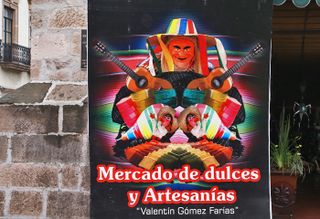
Morelia's Mercado de Dulces y Artesanías Valentín Gómez Farías (Candy and Artisans' Market), at the corner of Av. Madero and Calle Rayón, recently celebrated the 41st anniversary of its founding.
Imagine a market packed with nearly 170 booths filled with candy, hand-made toys, and cheerful vendors. Sound like a child's paradise? It certainly is, and an adults' paradise as well. Mexican candy comes in varieties worth drooling over: whole candied fruits, lollipops big enough for two or three days, tiny clay pots and baskets filled with goodies, haystacks of toasted coconut, and hundreds of other treats. There's nothing else quite like the candy made here.
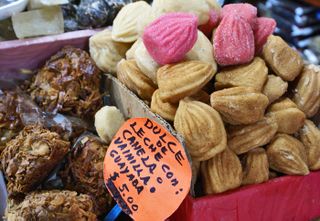
Dulce de leche, also known as jamoncillo, is similar to penuche–vanilla fudge. In Mexico, this candy may be flavored with vanilla, cinnamon, or guava.

Tarugos are made of tamarind paste (with the fiber removed) and are prepared either with sugar (left center) or with chile (right center). The word tarugo means a hunk–as in a hunk of bread, or candy–but it also means blockhead, or stupid, or oaf. Ay tarugo, se te cayó tu tarugo! (Oh you oaf, you dropped your tarugo!)
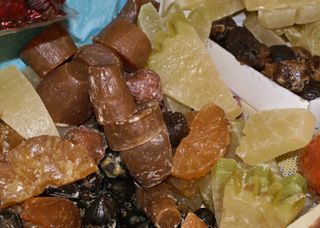
Frutas cubiertas (crystallized fruits). Clockwise from four o'clock: cactus, sweet potato, whole figs, sliced pineapple, and squash. To prepare these fruits, you peel them, seed them, and then boil them for three to five minutes in a syrup of piloncillo (brown sugar), water, and a few drops of jugo de limón (lemon juice). Remove the fruits and allow them to dry. Once the fruits are thoroughly dry, boil them one by one in the same syrup, until they are crystallized. The preparation process is, as you can imagine, extremely time-consuming.

Ates en cubitos (fruit pastes, in this case formed as small cubes). Ates originated in Morelia. They're made from membrillo, guayaba, perón, (quince, guava, and pear apple) as well as other fruits, including mango and durazno (peach). The fruits are cooked slowly, with plenty of sugar, until the mixture is stiff and can be formed in a mold.
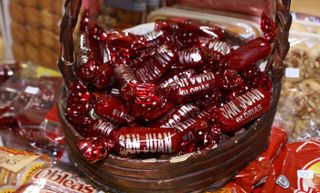
A basket filled with glorias–cajeta (goat or cow's milk cooked with sugar until richly brown and thick), mixed with pecans and individually wrapped.

Fruit liqueurs, rompope (bottled eggnog), chongos zamoranos (a milk and honey-based dessert), and powerful charanda–Michoacán's traditional sugarcane alcohol.
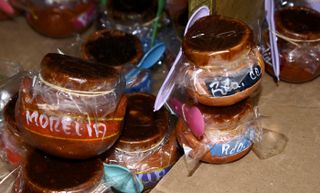
Ollitas de barro (tiny clay pots), each stuffed with sweet tamarind paste mixed with sugar, salt, and chile. One little plastic spoonful and you'll crave more of this sweet, savory, spicy mixture.
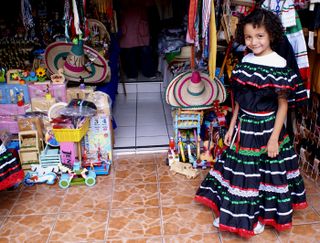
The mercado de dulces also sells traditional crafts and clothing. Yunuén Danae Ortiz Medina, seven years old and adorable, tried on several dresses suitable for Mexico's Independence Day holiday. She liked a similar white one better than this black one. "And of course I won't have this shirt on underneath when I wear it!"
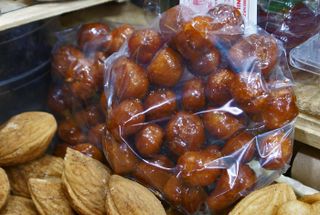
Home-made muéganos (half-inch balls of fried masa (dough), candied in piloncillo [brown sugar] syrup). The masa is the same as that prepared for buñuelos, but rolled into balls rather than extended into a flat sheet.

Cocadas (toasted coconut candy) look just like haystacks–two inches high! Cocadas originated in Mexico's coastal states. Prepare them with toasted coconut, condensed milk, and egg, then bake. Better yet, buy them ready to eat at the mercado de dulces.

A little bit of every kind of sweet packs this booth. Paletones (all-day suckers), alfajores (cocadas made of ground white coconut, the tops colored pink), cajeta (caramel candy), borrachitos (similar to gumdrop rolls filled with milk and alcohol), rollos de guayaba (rolls of guava paste, often filled with cajeta), and a dozen other kinds of candies.
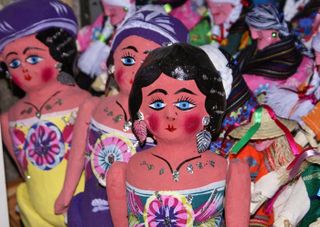
Exotic dolls, each about two feet tall and made of painted and bejeweled cardboard, occupy one corner of a candy stand.
Looking for a tailored-to-your-interests specialized tour in Mexico? Click here: Tours.
Leave a Reply